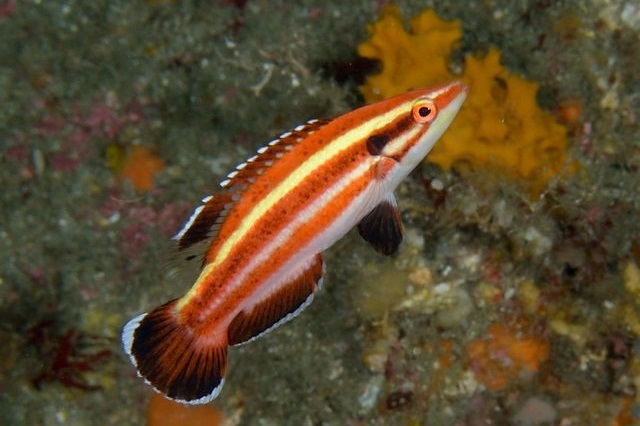Bodianus masudai

| Latin name | Bodianus masudai |
|---|---|
| Family | Labridae - Bodianus |
| Origin | Australia, Japan, Indonesia, New Zealand, Central/West Pacific |
| Max length | 12 cm (4.7") |
| Minimum volume |
500 l (132 gal) |
|---|---|
| Hardiness |
Hardy |
| Suitable for aquarium |
Suitable with care |
| Reef safe |
Reef safe with caution |
| Aggressiveness | Might be aggressive towards other species |
| Recommended |
Other invertebrates Small crustaceans (Krill, mysis, artemia...) Zooplankton (Cyclops, pods...) |
|---|
This species likes to eat worms, small bivalves and small crustaceans.
There is little available knowledge of this species, so there can be important information missing on this page.
This species searches through the sand for food, which can make the water cloudy and shakes up detritus.
In an aquarium their natural food source in the sand is quickly exhausted.
This species needs good hiding places, for example, between live rocks.
This species revels in swimming and requires an aquarium with ample space.
This species can change gender from female to male.
When a male is needed, a female changes sex and takes on the role.
This species can be very shy when first introduced into a new aquarium.
More aggressive fish can be introduced after this species has acclimatized.
Hogfish (Bodianus) get their name from the way they look for food in the substrate using their snout. They can regularly be seen blowing water down into the sand and in their natural habitat they often follow other fish which have disturbed it.
Hogfish are quite hardy and in time eat all the most common available fish foods. They do however, demand plenty of space to swim and for concealment.
They can hide for long periods of time if kept with more aggressive species. Hogfish can also be aggressive towards more docile species or those that resembles themselves.
When fully grown they can become a threat to various invertebrates, e.g. worms, snails, small bivalves and crustaceans amongst others.
Wrasses are nearly always seen in reef aquaria, since many of the species are both attractive and useful in battling a range of unwanted invertebrates like i.e. flatworms, pyramide snails.
These fish live of everything from zooplankton to large crustaceans, sea urchins and the like.
The needs and behaviour of Wrasses vary greatly, so it is vital to familiarize oneself with the specific species before buying one.
Bob Fenner. The Wrasses We Call Hogfishes - Wet Web Media - (English)
Scott Michael. 2002. Aquarium Fish: The Hogfishes, Family Labridae - Advanced Aquarist - (English)
Scott W. Michael. 2009. Wrasses and Parrotfishes (Reef Fishes Series Book 5) - TFH Publications / Microcosm Ltd. - (English)

